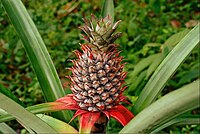
Photo from wikipedia
Mass spectrometry imaging is a powerful analytical technique for detecting and determining spatial distributions of molecules within a sample. Typically, mass spectrometry imaging is limited to the analysis of thin… Click to show full abstract
Mass spectrometry imaging is a powerful analytical technique for detecting and determining spatial distributions of molecules within a sample. Typically, mass spectrometry imaging is limited to the analysis of thin tissue sections taken from the middle of a sample. In this work, we present a mass spectrometry imaging method for the detection of compounds produced by bacteria on the outside surface of ant exoskeletons in response to pathogen exposure. Fungus-growing ants have a specialized mutualism with Pseudonocardia, a bacterium that lives on the ants' exoskeletons and helps protect their fungal garden food source from harmful pathogens. The developed method allows for visualization of bacterial-derived compounds on the ant exoskeleton. This method demonstrates the capability to detect compounds that are specifically localized to the bacterial patch on ant exoskeletons, shows good reproducibility across individual ants, and achieves accurate mass measurements within 5 ppm error when using a high-resolution, accurate-mass mass spectrometer.
Journal Title: ACS chemical biology
Year Published: 2017
Link to full text (if available)
Share on Social Media: Sign Up to like & get
recommendations!